|
NAMES AND ADDRESSES OF OFFICER AND ENLISTED PERSONNEL
APPEARING IN THE GROUP PICTURE OF THE 16 TOW TARGET SQUADRON
FRONT ROW LEFT TO RIGHT
Technical Sergeant Walter E. Everett, Canton, Ohio
Master Sergeant Charles L. Bradham, Mt. Carmel, Illinois
Technical Sergeant Lewis W. Flowers, Cleburne, Texas
Private First Class Claude Jones, Dunbow, West Virginia
Private First Class Francis L. Homer, Wildrose, North Dakota
Private First Class Roberto G. Munoz, Cuero, Texas
Corporal Arthur Levine, Bronx, New York
Corporal John S. Pavlovich, Gary, Indiana
Private First Class Rocco Varia, Los Angeles, California
Corporal Chester Sitko, Flint, Michigan
Corporal Dua Morvant, Abbeville, Louisiana
Private First Class Peter Fusco, Hoboken, New Jersey
Staff Sergeant Ishmael C. Evans, Sandpoint, Idaho
Staff Sergeant Richard W. Osborn, Louisville, Kentucky
Staff Sergeant Carl B. Gordner, Muncy, Pennsylvania
Staff Sergeant John E. Clayton, Durham, North Carolina
Staff Sergeant John F. Parry, Baltimore, Maryland
Staff Sergeant Elmer A. Petermann, Wibeaux, Montana
Staff Sergeant George Balaschak, Meriden, Connecticut
Staff Sergeant Darwin E. Ruff, Winterhaven, Florida
Staff Sergeant David C. Cox, Washington, D.C.
Staff Sergeant Winfred I. Buckner, Siler City, North Carolina
Staff Sergeant John J. Irwin, Kokorto, Indiana
[The B-25 Mitchell the guys are pictured with is named "Peggy" because it
is named in the document exactly as written below. This is the only real
clue we have. What bomb group or squadron flew and supported "Peggy"?]
"Peggy", B-25 Mitchell, United States Air Forces, Somewhere in the
Pacific
About the plane: The North American B-25 Mitchell was an American
twin-engine medium bomber manufactured by North American Aviation. It was
used by many Allied air forces, in every theater of World War II, as well
as many other air forces after the war ended, and saw service across four
decades.
The B-25 was named in honor of General Billy Mitchell, a pioneer of U.S.
military aviation. The B-25 is the only American military aircraft named
after a specific person. By the end of its production, nearly 10,000 B-25s
in numerous models had been built. These included a few limited
variations, such as the United States Navy's and Marine Corps' PBJ-1
patrol bomber and the United States Army Air Forces' F-10 photo
reconnaissance aircraft.
Staff Sergeant Fred A. Roczniak, Chicago, Illinois
Staff Sergeant Luther W. Gehring, Federalsburg, Maryland
Staff Sergeant Thomas B. Kirkpatrick, Fairbury, Nebraska
Staff Sergeant Dennistan J Papenheim, St. Paul, Minnesota
Staff Sergeant Vincent J. Poland, 241 Denison Parkway, Corning, New York
Staff Sergeant Walter T. Stone, Jr., Dunellen, New Jersey
Staff Sergeant Welton G. Replogle, Hemet, California
Staff Sergeant Maurice W. McCormick, Sebeka, Minnesota
Staff Sergeant Norman K. Bell, Joplin, Missouri
Corporal Harold F. LaShay, Fond du Lac, Wisconsin
Corporal John L. Connor, Lanham Hills, Maryland
Sergeant Harry E. Curtis, Roswell, New Mexico
Corporal John L. Gillick, Troy, New York
Corporal George D. Cuffman, Goodlettsville, Tennessee
Master Sergeant Joseph B. Wall, Los Angeles, California
Master Sergeant Michael B. Nader, Bowers, Montana
Sergeant Albert E. Kolfliech, Waukesha, Wisconsin
Sergeant Charles H. Gress, Sparta, Michigan
Corporal Edward J Jolly, Green Bay, Wisconsin
Sergeant John J. Wickey, Baldwin, New York
Corporal Edgar J. Haynes, Columbus, Ohio
SECOND ROW LEFT TO RIGHT
Sergeant Ralph J. Brown, Newton, Kansas
Corporal Wesley E. Carroll, Radford, Virginia
Corporal Jubil J. Hinton, Blair, Oklahoma
Corporal Jack Tompkins, Bronx, New York
Sergeant Charles P. Laterro, Cincinnati, Ohio
Private First Class Teddy DeLauro, Brooklyn, New York
Private First Class Albert J. Balek, St Louis, Missouri
Private First Class Lloyd W. Sedlacek, Osborn, Ohio
Corporal Franklin F. Smith, Latrobe, Pennsylvania
Private First Class Jesse J. Sanchez, Albuquerque, New Mexico
Sergeant Alexander Renny, Lawrence, Massachusetts
Corporal John L. Fischer, Cincinnati, Ohio
Corporal Harold A. Solari San Rafael, California
Private First Class Grover L, Cody, San Antonio, Texas
Second Lieutenant John H. Allers, Washington, D.C.
First Lieutenant Anders W. Johnson, Latrobe, Pennsylvania
Captain Isom C. Threatt, El Paso, Texas
First Lieutenant Wayne R. Unruh, Peabody, Kansas
First Lieutenant Charles E. Krause, Jourdanton, Texas
Second Lieutenant Otis T. King, Argyle, Texas
First Lieutenant William D. Ross, Cypress, California
First Lieutenant Ernie Boronstein, Chicago, Illinois
First Lieutenant George W. Guenther, Troy, New York
Second Lieutenant John F. Barnes, Batesville, Arkansas
Captain Harlis R. Koger, Caddo Mills, Texas
Captain Alton E. McQueen, Borger, Texas
First Lieutenant James F. Welsh, Moline, Illinois
Captain Clayton E. Smith, Muskegon, Michigan
Captain Leo C. Alverson, (Commanding Officer), Fairfield, Alabama
First Lieutenant Joseph E. Barclay, Moberly, Missouri
Second Lieutenant Harold K. Williams, Morrisville, Vermont
Second Lieutenant Dale H. Robson, Santa Monica, California
First Lieutenant Rueben S. Burnham, Newburyport, Massachusetts
First Lieutenant Edward D. Weber, Dallas, Texas
First Lieutenant William T. McRae, Courtland, California
Second Lieutenant Frank N. Price, Jr., Denver, Colorado
Second Lieutenant James L. Bailey, Schenectady, Near York
Second Lieutenant James E. Cobble, Jr., Knoxville, Tennessee
First Lieutenant Haley H. Carter, Dayton, Ohio
First Lieutenant James D. Hampton, Jr., Nashville, Tennessee
Second Lieutenant Theodore G. Heyse, Brooklyn, New York
Private First Class Thomas G. Heslep, Miami, Arizona
Corporal Joseph Ferreira, New Bedford, Massachusetts
Private First Class Charles D. Heslep, Wichita Falls, Texas
Private First Class Ralph A. Sullivan, Glassboro, New Jersey
Private First Class James W. Willett, Accokeek, Maryland
Private First Class Elvin L. France, Ludington, Michigan
Corporal Ernest J. Martel, Detroit, Michigan
Private First Class Gerald M. Lowry, Indianapolis, Indiana
Private First Class Edward R. Waggoner, Dimmitt, Texas
Private First Class Ruffus J. Baum, Portageville, Missouri
Sergeant Robert E. Jenkins, Des Moines, Iowa
Private Roland L. Cote, Nashua, New Hampshire
Corporal John H. Wyrybkowski, Detroit, Michigan
Sergeant James E, Rutkoskie, Los Angeles, California
Technical Sergeant John L. Simon, Morgantown, West Virginia
THIRD ROW LEFT TO RIGHT
Corporal Charles Colburn, Chicago, Illinois
Corporal Paul W. Dukeshire, Brooklyn, New York
Private First Class Kyle M. Collins, Dothan, Alabama
Sergeant Conrad R. Garner, Harrison, Arkansas
Private First Class Emory J. Thames, Girard, Georgia
Sergeant Loyd E. Wilson, Eutaw, Alabama
Private First Class Ulric Sheldon, San Antonio, Texas
Private First Class Emil M. Mesinger, New Orleans, Louisiana
Sergeant George J. Leahy, Chicago, Illinois
Private First Class William L. Henry, Texarkana, Texas
Private First Class George F. Lautenschlager, Chicago, Illinois
Private First Class Gurley Saul, Alkol, West Virginia
Private First Class Theodore Debonis, Troy, New York
Corporal Paul E. Widger, Cazenovia, New York
Private First Class David M. Gillon, East Point, Georgia
Corporal Alfred d. Turner, Danbury, Connecticut
Sergeant Norman L. Oliver, Los Angeles, California
Technical Sergeant Edward L. Lucas, Brazil, Indiana
Technical Sergeant Clarence E. Simenson, Duluth, Minnesota
Private First Class Robert Ladd, Medford, Oregon
Private First Class George Duran, Dixon, New Mexico
Sergeant Judson E. Oakes, Knoxville, Tennessee
Sergeant Charles A. Seka, Granite City, Illinois
Technical Sergeant Charles W. Rullman, Washington, D.C.
Private First Class George W. McLellan, Jr., Long Island City, New York
Corporal Seymour Steinbrecher, Philadelphia, Pennsylvania
Private First Class Ysidro Reyes, Lemesa, Texas
Private First Class Grady E. Austin, Rockwell, North Carolina
Sergeant Royce Hayley, San Angelo, Texas
Sergeant James E. Berry Jr., Whistler, Alabama
Sergeant Laverne F. Smith, Newark, New York
Sergeant Fernand A. Genest, Manchester, New Hampshire
Corporal Anthony Cristian, Detroit, Michigan
Private First Class Thomas D. Burfoot, Midolthian, Virginia
Private First Class Casimer J. Bystrzycki, Milwaukee, Wisconsin
Private First Class Alfred J. Bassil, Detroit, Michigan
Sergeant Floyd E Haley, Dayton Texas
Sergeant Andrew J. Whalen Jr., Griffin, Georgia
Corporal Palmer M. Cox Jr., Cotulla, Texas
Private First Class Wames J. Beirne, New York, New York
Corporal William W. Sides, Athens, Texas
Sergeant Walter Kamuta, Buffalo, New York
Sergeant Clate H. Victory, Howell, Georgia
Staff Sergeant Maurice C. Bateman, Fulton, New York
Corporal Bill C. Westfall, Spokane, Washington
Private First Class John A. Chapman, Rockford, Illinois
Corporal Philip E. Smith, Garden City, Texas
Private First Class Frank W. Ruh, Brackenridge, Pennsylvania
Private First Class Stanley J. Kosla, Chicago, Illinois
Staff Sergeant Cline C. Zolman, Thornville, Ohio
Staff Sergeant Floyd E. Roueche, Hershey, Nebraska
Corporal Howard VanGasbeck, Bridgeport, Wisconsin
Staff Sergeant Richard C. Kilgore, Kalamazoo, Michigan
Private First Class Oliver W. Goodwin, Aronas, California
FOURTH ROW LEFT TO RIGHT
Private First Class Edward S. Orlik, Bay City, Michigan
Private First Class Dale L. Mason, Beebee, West Virginia
Sergeant Harold G. Olmstead, Caribou, Maine
Private First Class Glenn W. Dibble, Rixford, Pennsylvania
Corporal Richard C. Winner, Yorkshire, Ohio
Corporal James R. Foster, Crafton, Pennsylvania
Corporal John L. Roberts, Kineola, Texas
Private First Class Ray D. Burgett, Ashland, Kentucky
Private First Class Francis H. Hein, New Orleans, Louisiana
Private First Class John W. Weikel, West Berlin, New Jersey
Corporal William F. Allen, Chester, Pennsylvania
Technical Sergeant Frank C. Vennis, Shinnston, West Virginia
Private First Class Henry A. Hurst, Jr., Philadelphia, Pennsylvania
FIFTH ROW LEFT TO RIGHT
Sergeant Lawrence J. Moran, New York, New York
Private First Class Arthur C, Southworth, Johnson City, New York
Staff Sergeant Harry M. Stanley, Pittsburgh, Pennsylvania
Private First Class William G. Lutsch, Medina, Ohio
Sergeant Albert Gay, New York, New York
Private First Class Jack R. Bruner, San Diego, California
Corporal Wayne M. Stevens, Seymour, Iowa
Private First Class Wayne L. Stearman, Humphrey, Oklahoma
Corporal Charles D. MacNeill, Jr., Berkeley, California
Private First Class Harry S. Hauck, Los Altos, California
Corporal John P. Gordon, South Ozone Park, New York City, NY.
Staff Sergeant Sydney G. Gadow, St. Paul, Minnesota
Private First Class Harold L. Riemer, Saxonburg, Pennsylvania
Corporal Robert L. Elam, Canton, Illinois
Corporal Alfred Gasaway, Detroit, Michigan
Technical Sergeant Mickey Kadylak, Greensburg, Pennsylvania
Sergeant Roger E. Lee, Hartford, Michigan
Sergeant Robert W. Wallace, Huntington, West Virginia
Corporal John H. Crytzer, Youngstown, Ohio
Technical Sergeant Oscar L. Johnson, Spokane, Washington
Technical Sergeant Emmett C Smith, Parkersburg, West Virginia
Master Sergeant Vilas A. Raasch, Wausau, Wisconsin
Technical Sergeant Joseph H. Crumpler, Goldsboro, North Carolina
Corporal William P. Vest Jr., Liberty, Kentucky
Corporal Clarence C Matteson, Benton City, Washington
Private First Class Bernard J. Noonan, Mill City, Oregon
Corporal Claude E. White, Belton, Texas
Corporal Henry W. Furmanski, Fruitport, Michigan
Corporal John J. Ruggerio, 162 Pleasant St., Watertown, Massachusetts
I would like information about the 16th Tow Target Squadron.
The 16th's Lineage, Assignments, Stations, Aircraft, Operations, Service
Streamers, Campaigns, Decorations and Emblem are asked for to complete
this dedication page. If anyone can provide any information, please email mike @
b26.com |
| World War II, WW2, Bombardment Groups and Squadrons related to
the 16th Tow Target Squadron by the number 16. It's a stretch but
relative and authoritative text and images helps us accomplish the goal of
developing the 16th Tow Target Squadron dedication page. 16th
BOMBARDMENT
LINEAGE. Constituted 16th Bombardment Squadron (Very Heavy) on 28 Mar
1944. Activated on 1 Apr 1944. Inactivated on 15 Apr 1946.
ASSIGNMENTS. 16th Bombardment Group, 1 Apr 1944-15 Apr 1946.
STATIONS. Dalhart AAFld, Tex, 1 Apr 1944; Fairmont AAFld, Neb, 15 Aug
1944-7 Mar 1945; Northwest Field, Guam, 14 Apr 1945-15 Apr 1946.
AIRCRAFT. B-17, 1944-1945; B-29, 1944-1946.
OPERATIONS. Combat in Western Pacific, 16 Jun-14 Aug 1945.
SERVICE STREAMERS. None.
CAMPAIGNS. Air Offensive, Japan; Eastern Mandates; Western Pacific.
DECORATIONS. Distinguished Unit Citation: Japan, 29 Jul-6 Aug 1945.
EMBLEM. A large, gray, caricatured hippopotamus, winged light yellow
orange, wearing a brown fatigue cap, and holding a large, brown and yellow
aerial bomb under the forelegs, while running toward dexter, in front of
and around a large blue sphere marked with black land areas and encircled
by a yellow and brown ribbon. (Approved 3 Aug 1945.)

16th COMBAT CARGO
LINEAGE. Constituted 16th Combat Cargo Squadron on 9 Jun 1944.
Activated on 13 Jun 1944. Inactivated on 29 Dec 1945. Disbanded on 8 Oct
1948.
ASSIGNMENTS. 4th Combat Cargo Group, 13 Jun 1944; AAF, India-Burma
Theater, 5 Sep 1945; 4th Combat Cargo Group, c. Oct-29 Dec 1945.
STATIONS. Syracuse AAB, NY, 13 Jun 1944; Bowman Field, Ky, 16 Aug-9 Nov
1944; Sylhet, India, 7 Dec 1944; Argartala, India, 26 Dec 1944; Chittagong,
India, 31 Jan 1945; Namponmao, Burma, II Jun 1945; Ledo, India, 3 Sep
1945; Namponmao, Burma, Oct 1945; Ondal, India, Nov-29 Dec 1945.
AIRCRAFT. C-47, 1944, 1945; C-46, 1944-1945.
OPERATIONS. Aerial transportation from India to Burma, 9 Dec 1944-Jun
1945, and subsequently from Burma to China.
SERVICE STREAMERS. None.
CAMPAIGNS. India-Burma; Central Burma; China Offensive.
DECORATIONS. None.
EMBLEM. Over and through a light blue disc, border red, piped white, a
caricatured brown vulture, proper, resting on small white cloud formation
and smoking a cigar, while wearing a radio head set and dropping a large
package held by the string in claws of right foot, and tipping a like
package off of the edge of the cloud formation with the tip of the left
wing. (Approved 23 Aug 1944.)

16th FIGHTER
LINEAGE. Constituted 16th Pursuit Squadron (Interceptor) on 20 Nov
1940. Activated on 15 Jan 1941. Redesignated: 16th Pursuit Squadron
(Fighter) on 12 Mar 1941; 16th Fighter Squadron on 15 May 1942.
Inactivated on 7 Dec 1945. Activated on 15 Oct 1946. Redesignated 16th
Fighter-Interceptor Squadron on 1 Feb 1950.
ASSIGNMENTS. 51st Pursuit (later Fighter) Group, 15 Jan 1941-7 Dec 1945
(attached to 23d Fighter Group, Jul 1942-Oct 1943). 51st Fighter (later
Fighter-Interceptor) Group, 15 Oct 1946; 51st Fighter-Interceptor Wing, 25
Oct 1957-.
STATIONS. Hamilton Field, Calif, 15 Jan 1941; March Field, Calif, 10
Jun 1941-11 Jan 1942; Karachi, India, 12 Mar 1942; Kunming, China, 27 Jun
1942 (detachment operated from Lingling, China, 10 Jul-Aug 1942);
Chungking, China, 17 Aug 1942; Kweilin, China, 27 Oct 1942; Chenyi, China,
29 Nov 1942 (detachment operated from Yunnani, China, 26 Dec 1942-Mar
1943); Kweilin, China, 31 Mar 1943; Hengyang, China, 20 Sep 1943;
Chengkung, China, 25 Nov 1943 (detachments operated from Tsuyung, China,
25 Nov 1943-Apr 1944; Nanning, China, Feb 1944; Szemao, China, Apr 1944;
Yunnani, China, May-Jul 1944; Liangshan, China, 16-31 Dec 1944; Kwanghan,
China, 24 Dec 1944-30 Jan 1945; Laohokow, China, 1 Jan-16 Mar 1945; Poseh,
China, 1 Feb-13 Apr 1945; Pakhoi, China, 7-19 Aug 1945); Nanning, China,
19 Aug 1945; Loping, China, Sep-Nov 1945; Camp Kilmer, NJ, 6-7 Dec 1945.
Yontan, Okinawa, 15 Oct 1946; Naha, Okinawa, 22 May 1947; Itazuke, Japan,
22 Sep 1950; Kimpo, Korea, 22 Oct 1950; Itazuke, Japan, 3 Jan 1951; Tsuiki,
Japan, 22 Jan 1951 (detachment operated from Suwon, Korea, 20 May-29 Jul
1951); Suwon, Korea, 29 Jul 1951; Misawa, Japan, Jul 1954; Naha, Okinawa,
1 Aug 1954-.
AIRCRAFT. P-40, 1941-1944; P-51, 1944-1945 P-47, 1946-1947; F-80,
1947-1951; F-86, 1951-1959; F-102, 1959-.
OPERATIONS. Combat in CBI, Jul 1942-25 Jul 1945. Combat in Korea, 22
Sep 1950-27 Jul 1953.
SERVICE STREAMERS. None.
CAMPAIGNS. World War II: New Guinea; India-Burma; China Defensive;
China Offensive. Korean War: UN Of 1952; Third Korean Winter; Korea
Summer-Fall, 1953.
DECORATIONS. Distinguished Unit Citation: Korea, 28 Nov 1951-30 Apr
1952. Republic of Korea Presidential Unit Citations: [22] Sep 1950-30 Jun
1951; 1 Jul 1951-31 Mar 1953. Air Force Outstanding Unit Awards: 29 Aug
1958-19 Jan 1959; 26 Mar 1962-30 Sep 1963.
EMBLEM. On a five-sided geometrical figure, per fess enhanced, Air
Force golden yellow and Air Force blue, an American Indian ceremonial
stake issuing from dexter base and extending beyond the perimeter of the
emblem in chief, striped palewise of four, black and red; the stake
pierced by a tomahawk bendwise, handle brown, blade white, border and
thongs black; all within a narrow black border. (Approved 16 Nov 1961. )

16th PHOTOGRAPHIC
LINEAGE. Constituted Photographic Laboratory Unit on 27 Mar 1942.
Activated on 31 Mar 1942. Redesignated: 16th Photographic Squadron on 8
Jul 1942; 16th Photographic Unit on 1 Feb 1943; 16th Domestic Photographic
Unit on 11 Aug 1943; 16th Photographic Squadron on 14 Sep 1944.
Inactivated on 16 Dec 1947.
ASSIGNMENTS. 1st Mapping (later Photographic Charting) Group, 31 Mar
1942; 11th Photographic Group, 1 Dec 1943 311th Photographic Wing, 5 Oct
1944 55th Reconnaissance Group, 1 Jun-16 Dec 1947.
STATIONS. Bolling Field, DC, 31 Mar 1942; Buckley Field, Colo, 1 Nov
1944; MacDill Field, Fla, 19 Apr 1946-16 Dec 1947.
AIRCRAFT. Principally C-78 (1942-1944), C-45/F-2 (1944-1947), and
B-17/F-9 (1946-1947), but also included OA-1-0, OA-1-3, and AT-7 (1943),
AT-11 (1943-1946), and F-13 (1947).
OPERATIONS. Mapping of areas of the United States.
SERVICE STREAMERS. American Theater.
CAMPAIGNS. None.
DECORATIONS. None.
EMBLEM. Over and through a light blue disc, a white caricatured bear,
grasping a black aerial camera proper in the forepaws, leaning and diving
through space on a wing section formed by two red planks, and having a
tail rudder of the same material, all emitting white speed lines.
(Approved 29 Mar 1943.)

16th RECONNAISSANCE
LINEAGE. Organized as 3d Aviation School Squadron on 9 May 1917.
Redesignated 16th Aero Squadron on 31 Aug 1917. Demobilized on 22 May
1919. Reconstituted and consolidated (1924) with 16th Squadron which was
authorized on 3o Aug 1921. Organized On 7 Dec 1921. Redesignated 16th
Observation Squadron on 25 Jan 1923. Inactivated on 15 Mar 1931. Activated
on 1 Jun 1937. Redesignated: 16th Observation Squadron (Medium) on 13 Jan
1942; 16th Observation Squadron on 4 Jul 1942; 16th Reconnaissance
Squadron (Bomber) on 31 May 1943; 16th Reconnaissance Squadron (Heavy,
Special) on 12 May 1944. Disbanded on 12 Apr 1945.
ASSIGNMENTS. Unkn, 9 May 1917-Jan 1918; Second Aviation Instruction
Center, Jan 1918-Feb 1919; Feb-22 May 1919. Seventh Corps Area (attached
to Cavalry School), 7 Dec 1921; 12th Observation Group (attached to
Cavalry School), 1 Oct 1930-15 Mar 1931. Fourth Corps Area, 1 Jun 1937
(flight attached, later assigned, to Infantry School until 20 Nov 1940);
Armored Force, 3 Oct 1940; 73d Observation Group, 1 Sep 1941 (attached to
68th Observation Group from Feb 1942) ; Army Air Forces, 12 Mar 1942; 68th
Observation (later Reconnaissance; Tactical Reconnaissance) Group, 29 Mar
1942 (attached to XII Air Force Service Command, 25 Sep 1943; Twelfth Air
Force, 1 Jan 1944; Fifteenth Air Force, 18 Feb 1944; AAF, MTO, 27 Mar
1944; Northwest African Air Forces, 2o Sep 1943; Mediterranean Allied Air
Forces, 10 Dec 1943; AAF, MTO, 1 Jan-26 May 1944); AAF, MTO, 26 May 1-944;
Army Air Forces, 3 Nov 1944-12 Apr 1945 (attached to 311th Photographic
Wing, 21 Nov 1944-12 Apr 1945) .
STATIONS. Memphis, Tenn, 9 May 1-917; Chicago, Ill, 20 May 1-91-7;
Chanute Field, Ill, c. 12 Jul 1917; Garden City, NY, 4 Nov-4 Dec 1917; St
Maixent, France, 1 Jan 1918; Tours, France, 24 Jan 1918; St Gervais,
Gironde, France, c. 12, Feb 1919; Bordeaux, France, 17-23 Apr 1919;
Mitchel Field, NY, c. 7-22 May 1919. Ft Riley, Kan, 7 Dec 1921-15 Mar
1931- (detachment operated between North Platte, Neb, and Rapid City, SD,
1- Aug-Sep 1927, and between Chicago, Ill, and Superior, Wis, 11 Jun-14
Sep 1928) . Pope Field, NC (flight at Lawson Field, Ga ), 1- Jun 1937;
Lawson Field, Ga, 24 Oct 1940; Daniel Field, Ga, 9 Feb 1942; Greensboro,
NC, 7 Jul 1942; Morris Field, NC, 15 Aug 1942; Langley Field, Va, 3-23 Oct
1942 (detachment at Wattisham, England, c. 5-21 Oct 1942); Fedala, French
Morocco, 9 Nov 1942; Casablanca, French Morocco, 12 Nov 1942; Oujda,
French Morocco, 10 Dec 1942; Berrecbid, French Morocco, 24 Mar 1943;
Berteaux, Algeria, 6 Sep 1943; Foch Field, Tunisia, 26 Sep 1943
(detachments operated intermittently from several points in Italy and
adjacent islands during period Oct 1-943-Mar 1-944; operated primarily
from Foggia, Italy, after 28 Mar 1944); Foggia, Italy, 3 May-30 Oct 1944
(detachment operated from Borgo, Corsica, until Sep 1944); Bradley Field,
Conn, 20 Nov 1944; Buckley Field, Colo, 1 Dec 1944-12 Apr 1945.
AIRCRAFT. JN-4, 1917. In addition to DH-4, c. 1922-1926, and O-2,
1926-1930, included JNS-1, O-1, and apparently JN-4 and JN-6 during period
1921-1930; 0-25, 1-930-1-931. In addition to 0-46, 1937-c. 1939,
0-47,1938-1-942, and 0-49, 1941-1942, included C-8, YG-1, and 0-43 during
period 1937-1940, 0-51 and 0-54 during period 1940-1941, and DB-7, L-4,
P-40, and P-43 during 1942; A-20 and P-39, 1942-1943; P-38, P-39, P-40,
and Spitfire, 1943; primarily B-17, 1943-1944; B-2-5,1945.
OPERATIONS. Flying training unit, 1917; maintained and repaired
aircraft, 1917-1919. Flew mail to President vacationing in South Dakota
and Wisconsin, Aug-Sep 1927, Jun-Sep 1928. Antisubmarine patrols in
western Mediterranean, c. 2o Dec 1942-7 Mar 1943; operated school for
fighter pilots, Mar-23 Sep 1943; combat in MTO and ETO as radar detection
and countermeasures unit, 27 Sep 1943-26 Sep 1944.
SERVICE STREAMERS. World War I: Theater of Operations. World War II:
American Theater.
CAMPAIGNS. Air Offensive, Europe; Algeria-French Morocco with
Arrowhead; Naples-Foggia; Anzio; Rome-Arno; Normandy; Southern France;
North Apennines; Rhineland; Antisubmarine, EAME Theater; Air Combat, EAME
Theater.
DECORATIONS. Distinguished Unit Citation: Mediterranean area, 1 Oct
1943-31 Jan 1944.
EMBLEM. A pair of binoculars, white with black line shading. (Approved
1 Apr 1924.)

16th TROOP CARRIER
LINEAGE. Constituted 16th Transport Squadron on 20 Nov 1940. Activated
on 11 Dec 1940. Redesignated 16th Troop Carrier Squadron on 4 Jul 1942.
Inactivated on 31 Jul 1945. Activated on 1g May 1947. Inactivated on 10
Sep 1948. Redesignated 16th Troop Carrier Squadron (Assault, Light) on 19
Sep 1950. Activated on 5 Oct 1950. Redesignated 16th Troop Carrier
Squadron (Assault, Fixed Wing) on 8 Nov 1954- Inactivated on 8 Jul 1955.
ASSIGNMENTS. 64th Transport (later Troop Carrier) Group, 11 Dec 1940-31
Jul 1945. 64th Troop Carrier Group, 19 May 1947-10 Sep 1948. 316th Troop
Carrier Group, 5 Oct 1950; Eighteenth Air Force (attached to 463d Troop
Carrier Wing), 14 Nov 1954-8 Jul 1955.
STATIONS. McClellan Field, Calif, 11 Dec 1940; Portland, Ore, 9 Jul
1941; Westover Field, Mass, 12, Jun-31 Jul 1942; Ramsbury, England, 18
Aug-Nov 1942 (operated from Maison Blanche, Algeria, 11 Nov-Dec 1942) ;
Blida, Algeria, c. 12 Dec 1942; Kairouan, Tunisia, 28 Jun 1943; El Djem,
Tunisia, 26 Jul 1943; Comiso, Sicily, 4 Sep 1943 (operated from bases in
India, Apr-Jun 1944; Ciampino, Italy, 10 Jul 1944 (operated from Istres,
France, 7 Sep-11 Oct 1944) ; Rosignano Airfield, Italy, 1o Jan-23 May 1945
(operated from Brindisi, Italy, 29 Mar-13 May 1945); Waller Field,
Trinidad, 4 Jun-31 Jul 1945. Langley Field, Va, 19 May 1947-10 Sep 1948.
Sewart AFB, Tenn, 5 Oct 1950; Ardmore AFB, Okla, 14 Nov 1.54-8 Jul 1955
AIRCRAFT. C-47, 1941-1945. C-119, 1950-1951; YC-122, 1951-1955 H-19,
1952; H-5, 1952.
OPERATIONS. World War II: Included airborne assaults on Sicily and
Southern France; support for partisans in Northern Italy, Jan-May 1945;
aerial transportation in MTO, and briefly in CBI. Unmanned, 1947-1948.
SERVICE STREAMERS. American Theater.
CAMPAIGNS. Algeria-French Morocco; Tunisia; Sicily; Naples-Foggia;
Rome-Arno; Southern France; North Apennines; Po Valley; India-Burma; Air
Combat, EAME Theater.
DECORATIONS. Distinguished Unit Citation: CBI Theater, 7 Apr-15 Jun
1944.
EMBLEM. On a disc yellow, piped blue, the stylized arrow head red,
winged white, piped blue. (Approved 25 Jun 1951. )
 |
